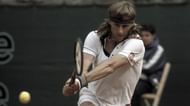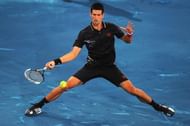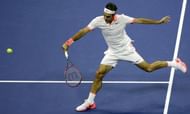The last forty years have seen a fundamental change in the way male and female professionals play tennis.
In the last two decades, Tennis fans have had the fortune of seeing shots and tactics that had never been seen before.
These shots have revolutionized the game, with these shots shaping the identities of the players involved, as well as proving influential for the styles adopted by future tennis stars.
These shots have come in an era, where the sport has evolved both tactically and, in terms of athleticism and physicality.
With players covering the court faster than ever and striking with more spin and power than ever, these very distinct shots are becoming a common feature of today's game.
Even with that being the case, we are still able to marvel at the strategic genius and physical strength required to execute these shots.
#5 Rafael Nadal - "Buggy-Whip" forehand
Rafael Nadal's "Buggy-Whip" forehand continues to be one of tennis' most renowned shots, with this shot being key to the Spaniard's success.
His forehand is a serious weapon, which overpowers opponents due to the amount of pace and spin on the ball. The Mallorcan's forehand is also an amazing defensive shot, allowing him to hit winners and retrieve balls from impossible angles.
The technique is also unconventional, with Nadal having a more open stance and his racket head finishing almost over his head.
In comparison, most players on the ATP and WTA have a much more conventional forehand, which is hit with a closed stance and a racket finish over the shoulder.
One truly remarkable shot is the so-called “banana” forehand. This is where Nadal strikes the ball around the opponent and sometimes even the net, with the ball still landing in the court.
The spin generated by Nadal's forehand motion, allows him to do this at will. The forehand is a staple part of Nadal’s game, making it one of, modern tennis’ greatest and most dangerous shots.
Here are some examples of this stunning shot:
#4 Bjorn Borg – two-handed backhand

Whilst everyone during the 1970's and 1980's, used the one-handed backhand, Bjorn Borg was developing and implementing a stroke that has become the norm right across the ATP and WTA tour; the two-handed backhand.
When Borg first introduced this shot, critics were quick to dismiss it believing there was no way this could work in matches.
However, the two-handed backhand gave the Swede an advantage, particularly on a clay court, where the two-handed backhand today, can absorb the high bounce from the surface better than the single-handed backhand.
The revolution really started to occur in the 1990's, where players such as Jim Courier and Andre Agassi, started to use this technique. This may have been frowned upon and questioned, but is now a common part of the modern game, used on all surfaces.
Here is a video showing Borg's groundstrokes, including the double-handed backhand:
#3 Novak Djokovic – sliding forehand and backhand

Back in 2015, a joint study conducted by Samir Bencic and Health Fitness Revolution, decided who was the greatest athlete from a list of sporting icons.
On top of that pile, came Djokovic. This pile included the likes of Michael Jordan, Cristiano Ronaldo, Michael Phelps and LeBron James, making Djokovic’s athletic ability seem even more spectacular.
The greatest example of this in action is with Novak’s sliding forehand and backhand. The Serb’s flexibility allows him to stretch every muscle and joint in his body, to retrieve and hit passing shots from near-on impossible angles, and in situations where most would surrender the point.
For many players, relying on defence is dangerous. However, with Djokovic’s speed around the court, and his ability to do slide into shots, his amazing defence is a truly reliable tool. This is a style copied by Hyeon Chung, who has a style that mirrors his “idol” Djokovic.
#2 Roger Federer – SABR (Sneak Attack By Roger)

This is a tactic, that was enhanced and constructed by Federer, during the latter part of 2015, during the American and indoor hard-court season.
This involves rushing to the net, just as the opponent has finished their service motion and taking the ball very early on the half-volley.
This pressurizes the person on the other side, as you are in an offensive position right from the start of the rally.
This gives the opponent little time to think, causing them to panic, hitting a shot they might not necessarily be comfortable with. This was a tactic used by Nick Krygios, who did this very effectively against Alexander Zverev, even using this tactic from a first serve.
To use this tactic effectively, one's reactions and skills need to be extremely fast, even for most ATP and WTA players. However, this is a strategy that could be used more often, giving the opponent, an extra problem to think about.
#1 Andre Agassi and Lleyton Hewitt - baseline tennis

Until the 1990s, grass court tennis had been played using the serve-and-volley style. This was the style adopted by the likes of John McEnroe, Pete Sampras, and Goran Ivanisevic.
The fast surface allowed these players to use their booming serve and their volleys to finish points quickly. However, the courts slowed down, with spectators not happy with the lack of rallies in the tournament.
This seismically changed in the world of tennis, as courts began to favour the baseline player.
As a result, the number of predominantly serve-and-volley players started to diminish. The first baseliner to win at Wimbledon was Andre Agassi, who defeated Goran Ivanisevic in the 1992 Wimbledon Final.
During the early 2000’s, Lleyton Hewitt adopted a more defensive form of baseline tennis, as he scrambled across the court to win points.
Roger Federer hailed Hewitt’s “unbelievable” influence on modern tennis, saying,
"I think for a base-liner, he was the first guy really from the baseline to have such a major impact as well".
Ever since Lleyton Hewitt won Wimbledon in 2002, every winner has played predominantly near the baseline.
What is the foot injury that has troubled Rafael Nadal over the years? Check here
